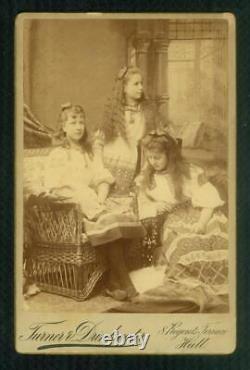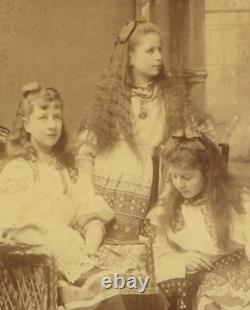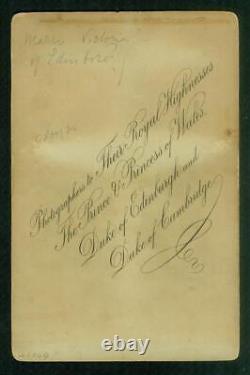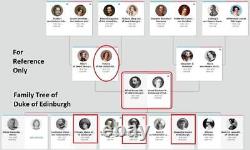S10, 025-01, 1890s, Cabinet Card, English Royalty Maria, Victoria and Alexandra







S10, 025-01, 1890s, Cabinet Card, English Royalty; Maria, Victoria and Alexandra. Photograph, English Royalty; Princesses Marie Alexandra Victoria, Victoria Melita and Alexandra Louise Olga, about 12-15 years old. They are the daughters of Alfred, Duke of Saxe-Coburg and Grand Duchess Maria Alexandrovna of Russia and grand daughters of. Family Tree (see last image). More Info on these 3 Sisters.
Marie (born Princess Marie Alexandra Victoria of Edinburgh ; 29 October 1875 - 18 July 1938). Was the last queen of Romania.
As the wife of King Ferdinand I. Marie was born into the British royal family.
Her parents were Prince Alfred, Duke of Edinburgh. (later Duke of Saxe-Coburg and Gotha), and Grand Duchess Maria Alexandrovna of Russia. Marie's early years were spent in Kent, Malta. After refusing a proposal from her cousin, the future King George V. She was chosen as the future wife of Ferdinand, then crown prince of Romania, in 1892. Marie was crown princess between 1893 and 1914, and became immediately popular with the Romanian people. Grand Duchess Victoria Feodorovna of Russia (born Princess Victoria Melita of Edinburgh ; 25 November 1876 - 2 March 1936), was the third child and second daughter of Alfred, Duke of Saxe-Coburg and Gotha. And Grand Duchess Maria Alexandrovna of Russia.She was a granddaughter of both Queen Victoria of the United Kingdom. And Emperor Alexander II of Russia. Victoria spent her early life in England and lived for three years in Malta, where her father served in the Royal Navy.
In 1889, the family moved to Coburg. Where Victoria's father became the reigning duke in 1893. In her teens, Victoria fell in love with her maternal first cousin Grand Duke Kirill Vladimirovich of Russia. Faith discouraged marriage between first cousins.
Bowing to family pressure, Victoria married her paternal first cousin Ernest Louis, Grand Duke of Hesse and by Rhine. The marriage failed - Victoria scandalized the royal families of Europe when she divorced her husband in 1901. The couple's only child, Princess Elisabeth. Died of typhoid fever in 1903. Princess Alexandra of Saxe-Coburg and Gotha.(Alexandra Louise Olga Victoria; 1 September 1878 - 16 April 1942) was the fourth child and third daughter of. Alfred, Duke of Saxe-Coburg and Gotha.
Grand Duchess Maria Alexandrovna of Russia. She was Princess consort of. She was a granddaughter of both.Of the United Kingdom and Tsar. Photographer: Turner & Drinkwater, 8 Regents Terrace, Hull, England. Card size: 4.25" x 6.5". Was a style of photograph which was widely used for photographic portraiture after 1870.
It consisted of a thin photograph mounted on a card typically measuring 108 by 165 mm (4+1? The carte de visite was displaced by the larger cabinet card in the 1880s.
In the early 1860s, both types of photographs were essentially the same in process and design. Both were most often albumen prints, the primary difference being the cabinet card was larger and usually included extensive logos and information on the reverse side of the card to advertise the photographer's services. However, later into its popularity, other types of papers began to replace the albumen process. Despite the similarity, the cabinet card format was initially used for landscape views before it was adopted for portraiture.Some cabinet card images from the 1890s have the appearance of a black-and-white photograph in contrast to the distinctive sepia toning notable in the albumen print process. These photographs have a neutral image tone and were most likely produced on a matte collodion, gelatin or gelatin bromide paper. Sometimes images from this period can be identified by a greenish cast.
Gelatin papers were introduced in the 1870s and started gaining acceptance in the 1880s and 1890s as the gelatin bromide papers became popular. Matte collodion was used in the same period. A true black-and-white image on a cabinet card is likely to have been produced in the 1890s or after 1900.
The last cabinet cards were produced in the 1920s, even as late as 1924. Owing to the larger image size, the cabinet card steadily increased in popularity during the second half of the 1860s and into the 1870s, replacing the carte de visite as the most popular form of portraiture. The cabinet card was large enough to be easily viewed from across the room when typically displayed on a cabinet, which is probably why they became known as such in the vernacular. Whatever the name, the popular print format joined the photograph album as a fixture in the late 19th-century Victorian parlor. Please see scans for actual condition.
(images 4, 5 & 6 are for reference only). This Cabinet Card would make a great addition to your collection or as a Gift (nice for Framing). Newest Collections with FREE S&H. To see all my Postcards. To see all my Movie Items.
To see all my Disney Items. To see all my Baseball Items. To see all my Boy Scout Cards.
To see all my Stereoview Cards. Add me to your Favorite Sellers and Sign up for my Newsletter. Ground Advantage (the old 1st class). Please look at my other Auctions for more Collectibles of the 1800's-1900's. Auctiva offers Free Image Hosting and Editing.
